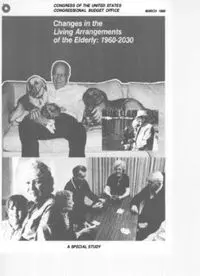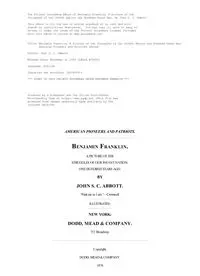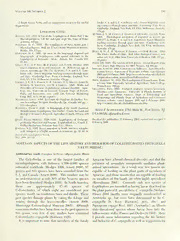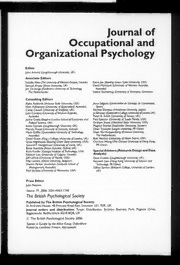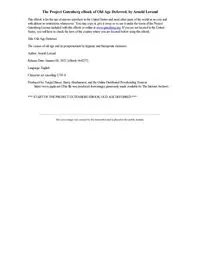
In Vivo Perfusion and Release of Neroactive Substances. Methods and Strategies PDF
Preview In Vivo Perfusion and Release of Neroactive Substances. Methods and Strategies
Contributors CHRISTOPHER D. ANDREWS KENNETH E. MOORE BENITO ANTON KATHYRNE J. MUELLER ALEJANDRO BAYON JANN A. NIELSEN CLAES-HENRIC BERTHOLD KAZUO NUNOKI IRENE CASTANO BRITTA NYSTROM ANDRE CHERAMY MARIA TRINIDAD PACHECO JOSE M. R. DELGADO ATHINEOS PHILIPPU DAVID DIAZ-PONTONES QUENTIN J. PITTMAN RENE DRUCKER-COLIN VICTOR D. RAMIREZ FRANCISCO ESTRADA-VILLANUEVA PETER REDGRAVE JACQUES GLOWINSKI RAFAEL MARTIN DEL RIO ANDERS HAMBERGER RANULFO ROMO DEAN R. HAUBRICH WILLIAM D. RUWE TOSHIHIKO IIJIMA MATS SANDBERG INGEMAR JACOBSON EUGENE P. SCHOENER BIRGITTA KARLSSON SARA SOLANO NORMAN W. KASTING JOSE M. SOLIS PETER J. KNOTT H. S. SWARTZWELDER JAKOB KORF JAN A. M. VAN DER HEYDEN K. LEDERIS WARREN L. VEALE ANDERS LEHMANN FRANCISCO VELASCO JUAN LERMA MARCOS VELASCO GREGORY E. MARTIN KOR VENEMA IN VIVO PERFUSION AND RELEASE OF NEUROACTIVE SUBSTANCES Methods and Strategies Edited by ALEJANDRO BAYON Departamento de Biologia Molecular Instituto de Investigaciones Biomedicas Universidad Nacional Autonoma de Mexico Mexico City, Mexico RENE DRUCKER-COLIN Centro de Investigaciones en Fisiologfa Celular Universidad Nacional Autonoma de Mexico Mexico City, Mexico 1985 ACADEMIC PRESS, INC. (Harcourt Brace Jovanovich, Publishers) Orlando San Diego New York London Toronto Montreal Sydney Tokyo COPYRIGHT © 1985, BY ACADEMIC PRESS, INC. ALL RIGHTS RESERVED. NO PART OF THIS PUBLICATION MAY BE REPRODUCED OR TRANSMITTED IN ANY FORM OR BY ANY MEANS, ELECTRONIC OR MECHANICAL, INCLUDING PHOTOCOPY, RECORDING, OR ANY INFORMATION STORAGE AND RETRIEVAL SYSTEM, WITHOUT PERMISSION IN WRITING FROM THE PUBLISHER. ACADEMIC PRESS, INC. Orlando, Florida 32887 United Kingdom Edition published by ACADEMIC PRESS INC. (LONDON) LTD. 24-28 Oval Road, London NW1 7DX Library of Congress Cataloging in Publication Data Main entry under title: In vivo perfusion and release of neuroactive substances. Includes index. 1. Neurotransmitters. 2, Brain chemistry. 3. Per fusion (Physiology). I. Bayon, Alejandro. II. Drucker- Colin, Rene Raul. [DNLM: 1. Neurochemistry. 2. Brain Chemistry. 3. Neuroregulators-physiology. 4. Per fusion. QV 126 135] QP364.7.I5 1985 599.01*88 84-21541 ISBN 0-12-083350-6 (alk. paper) PRINTED IN THE UNITED STATES OF AMERICA 85 86 87 88 9 8 7 6 5 4 3 2 1 Contributors Numbers in parentheses indicate the pages on which the authors' contributions begin. Christopher D. Andrews (141), Department of Pharmacology, Marshall University School of Medicine, Huntington, West Virginia 25704 Benito Anton (69), Departamento de Biologfa Molecular, Instituto de Investigaciones Biomedicas, Universidad Nacional Autonoma de Mexico, 04510 Mexico City, Mexico Alejandro Bayon (1, 69), Departamento de Biologfa Molecular, Instituto de Inves tigaciones Biomedicas, Universidad Nacional Autonoma de Mexico, 04510 Mex ico City, Mexico Claes-Henric Berthold (119), Department of Anatomy, University of Goteborg, S-400 33 Goteborg, Sweden Irene Castano (69), Departamento de Biologfa Molecular, Instituto de Investiga ciones Biomedicas, Universidad Nacional Autonoma de Mexico, 04510 Mexico City, Mexico Andre Cheramy (161), Chaire de Neuropharmacologie, Groupe NB, College de France, 75231 Paris 05, France lose M. R. Delgado (95), Departamento de Investigacion, Centro Ramon y Cajal, Madrid 28034, Spain David Diaz-Pontones (69), Departamento de Biologfa Molecular, Instituto de Inves tigaciones Biomedicas, Universidad Nacional Autonoma de Mexico, 04510 Mex ico City, Mexico Rene Drucker-Colin (1), Centro de Investigaciones en Fisiologfa Celular, Univer sidad Nacional Autonoma de Mexico, 20 Mexico City, Mexico Francisco Estrada-Villanueva (271), Division of Neurophysiology, Scientific Re search Department, National Medical Center, Instituto Mexicano del Seguro So cial, 03020 Mexico City, Mexico Jacques Glowinski (161), Chaire de Neuropharmacologie, Groupe NB, College de France, 75231 Paris 05, France Anders Hamberger (119), Institute of Neurobiology, University of Goteborg, S-400 33 Goteborg, Sweden xi xii Contributors Dean R. Haubrich* (293), Department of Pharmacology, Merck Sharp & Dohme Research Laboratories, West Point, Pennsylvania 19486 Toshihiko lijima (41), Department of Pharmacology, Tohoku University School of Medicine, Sendai 980, Japan Ingemar jacobson (119), Institute of Neurobiology, University of Goteborg, S-400 33 Goteborg, Sweden Birgitta Karlsson (119), Institute of Neurobiology, University of Goteborg, S-400 33 Goteborg, Sweden Norman W. Kasting (233), Department of Physiology, University of British Colum f bia, Vancouver, British Columbia, Canada Peter j. Knott (141), Department of Pharmacology, Marshall University School of Medicine, Huntington, West Virginia 25704 Jakob Korf (51), Department of Biological Psychiatry, University Psychiatric Clinic, 9713 EZ Groningen, The Netherlands K. Lederis (233), Department of Medical Physiology, Faculty of Medicine, University of Calgary, Calgary, Alberta T2N 4N1, Canada Anders Lehmann (119), Institute of Neurobiology, University of Goteborg, S-400 33 Goteborg, Sweden Juan Lerma (95), Departamento de Investigacion, Centro Ramon y Cajal, Madrid 28034, Spain Gregory E. Martin* (293), Department of Pharmacology, Merck Sharp & Dohme Research Laboratories, West Point, Pennsylvania 19486 Kenneth E. Moore (177), Department of Pharmacology and Toxicology, Michigan State University, East Lansing, Michigan 48824 Kathyrne], Mueller (141), Department of Pharmacology, Marshall University School § of Medicine, Huntington, West Virginia 25704 Jann A. Nielsen (177), Department of Pharmacology and Toxicology, Michigan State University, East Lansing, Michigan 48824 Kazuo Nunoki (41), Department of Pharmacology, Tohoku University School of Medicine, Sendai 980, Japan Britta Nystrom (119), Institute of Neurobiology, University of Goteborg, S-400 33 Goteborg, Sweden Maria Trinidad Pacheco (271), Division of Neurophysiology, Scientific Research Department, National Medical Center, Instituto Mexicano del Seguro Social, 03020 Mexico City, Mexico Athineos Philippu (221), Department of Pharmacodynamics and Toxicology, Uni versity of Innsbruck, A-6020 Innsbruck, Austria f •Present address: Sterling-Winthrop Research Institute, Rensselaer, New York 12144. Present address: Departments of Psychiatry and Pharmacology, The Mount Sinai Medical Center, One Gustave L. Levy Place, New York, New York 10029. ^Present address: McNeil Pharmaceutical, Department of Biological Research, Spring House, Pennsylvania 19477. §Present address: Program of Pharmacology, Northeastern Ohio University, College of Medicine, Rootstown, Ohio 44272. Contributors xiii Quentin I. Pittman (233), Department of Medical Physiology, Faculty of Medicine, University of Calgary, Calgary, Alberta T2N 4N1, Canada Victor D. Ramirez (249), Department of Physiology and Biophysics, University of Illinois, Urbana, Illinois 61801 Peter Redgrave (11), Department of Psychology, University of Sheffield, Sheffield S10 2TN, England Rafael Martin del Rio, (95), Departamento de Investigacion, Centro Ramon y Cajal, Madrid 28034, Spain Ranulfo Romo (161), Chaire de Neuropharmacologie, Groupe NB, College de France, 75231 Paris 05, France William D. Ruwe (233), Department of Medical Physiology, Faculty of Medicine, University of Calgary, Calgary, Alberta T2N 4N1, Canada Mats Sandberg (119), Institute of Neurobiology, University of Goteborg, S-400 33 Goteborg, Sweden Eugene P. Schoener (25), Department of Pharmacology, Wayne State University, School of Medicine, Detroit, Michigan 48201 Sara Solano (69), Departamento de Biologfa Molecular, Instituto de Investigaciones Biomedicas, Universidad Nacional Autonoma de Mexico, 04510 Mexico City, Mexico lose M. Solis (95), Departamento de Investigacion, Centro Ramon y Cajal, Madrid 28034, Spain H. 5. Swartzwelder (201), Department of Medicine, Division of Neurology, Duke University Medical Center, Durham, North Carolina 27705 Ian A. M. van der Heyden (51), Department of Pharmacology, Duphar B. V., 1380 AA Weesp, The Netherlands Warren L. Veale (233), Department of Medical Physiology, Faculty of Medicine, University of Calgary, Calgary, Alberta T2N 4N1, Canada Francisco Velasco (271), Division of Neurophysiology, Scientific Research Depart ment, National Medical Center, Instituto Mexicano del Seguro Social, 03020 Mexico City, Mexico Marcos Velasco (271), Division of Neurophysiology, Scientific Research Depart ment, National Medical Center, Instituto Mexicano del Seguro Social, 03020 Mexico City, Mexico Kor Venema (51), Department of Biological Psychiatry, University Psychiatric Clinic, 9713 EZ Groningen, The Netherlands Preface The birth of neuroscience as an interdisciplinary subject largely originated from the necessity of unifying the conceptual maps produced within the different traditional disciplines studying the nervous system. The in vivo techniques that allow the concerted study of neurochemical, phar macological, electrophysiological, and behavioral aspects of brain function have played a paramount role in this endeavor. In spite of the fact that these techniques—the subject matter of this book—have for two decades been our main window for the direct observation of these correlations, their use within the scientific community has been limited by misinformation, mis conceptions, and/or inexperience. Only recently has this panorama begun to change. As a result of improved procedures, probes, and detectors, and due to the availability of more specific and sensitive neurochemical assays, these techniques have provided new strategies for the study of brain func tion, and their success has resulted in the recognition of their unique value. The feeling that these developments are opening a new epoch for the in vivo study of the brain has stimulated several scientific events on this topic, including a symposium in the Annual Meeting of the Society for Neuro science (1981), a workshop at the European Society for Neuroscience (1981), and recently a symposium entitled "/n Vivo Release of Neuroactive Substances in the CNS," held in 1983 in Mexico City. From these meetings it was clear that in this changing scientific atmosphere it is necessary not just to analyze the emerging possibilities and alternatives, but also to evaluate the state of the art and the depth of its accomplishments. Our main concern in editing this book is to provide the reader with sound criteria to engage with, use, and improve on the methods and strategies utilized to study in vivo neurochemistry, in order to correlate it with elec trophysiological and behavioral events. We do not intend to give the best of recipes for in vivo perfusion and release techniques. This is possible only by careful consideration of current knowledge and personal experience, along xv xvi Preface with practical tests of the suitability of the methods for one's own neces sities. Nonetheless, in the Introduction we present an overview of meth odological alternatives and experimental strategies that we think are critical for the outcome of this type of research. The chapters that follow collect personal experiences on the study of in vivo neurochemistry and of its correlation with other neural events, contributed by representative scientists whose efforts have made possible the optimization of current techniques and the development of new ones. The chapters have been written and edited to facilitate the evaluation and comparison of the different techniques and experimental strategies used by the authors. Chapters in Part I concen trate on detailed descriptions of the probes and procedures used in this research and also provide a critical evaluation of the potentialities and limitations of the methodologies employed. Chapters in Part II exemplify the variety of experimental strategies in which these techniques have been used, gathering understanding on the chemical, bioelectrical, and behavioral as pects of brain function. They also illustrate interdisciplinary techniques for approaching problems of neuronal connectivity, neuroendocrinology, motor behavior, neuropathology, etc. We think this is a timely review, not just for the specialist, who surely will find this a useful, updated reference text, but for neuroscientists and students who have not had contact with this field and who may now find that these developments could open new possibilities for their own research interests. The editors are grateful to the Direccion General de Asuntos del Personal Academico (DGAPA) and to the Coordinacion de la Investigacion Cientffica (CIC) of the Universidad Nacional Autonoma de Mexico, without whose support this book could not have been written. We also thank Mrs. Martha Sarmiento for her patient clerical work. Alejandro Bayon Rene Drucker-Colin 1 Introduction ALEJANDRO BAYON Departamento de Biologia Molecular Instituto de Investigaciones Biomedicas Universidad Nacional Autonoma de Mexico Mexico City, Mexico RENE DRUCKER-COLIN Centro de Investigaciones en Fisiologia Celular Universidad Nacional Autonoma de Mexico Mexico City, Mexico Methodological Alternatives and Experimental Strategies for Studying the in Vivo Perfusion and Release of Neuroactive Substances in the Central Nervous System 1 References 7 METHODOLOGICAL ALTERNATIVES AND EXPERIMENTAL STRATEGIES FOR STUDYING THE IN VIVO PERFUSION AND RELEASE OF NEUROACTIVE SUBSTANCES IN THE CENTRAL NERVOUS SYSTEM Twenty-seven years ago Fox and Hilton (/) designed a system of parallel needles to perfuse subcutaneous tissue, which was modified by J. H. Gad- dum (2) into two concentric tubes—push-pull cannula—making it possible to perform in vivo experiments "to localize the site of liberation of sub stances in such tissues as the central nervous system, more precisely than by other means." In order to better understand the importance and conse quences of this development, which revolutionized in vivo neurochemistry, one must compare it with alternate superfusion techniques. Perfusion meth ods, push-pull cannulae systems included, are based on the same working principle: controlled infusion and simultaneous withdrawal of an artificial physiological fluid through the nervous tissue. This procedure creates a stream that interfaces with tissular elements, allowing bidirectional diffusion 1 IN VIVO PERFUSNI OAND RELEAES Copyright © 1985 by Academic Pres,s Inc. OF NEUROACTE IVSUBSTANSC E All rights of reproduction in any form reserved. ISBN 0-12-083350-6 2 Alejandro Bayon and Rene Drucker-Colin between the tissue and the exogenous fluid. The possibility of adding neu roactive chemicals to the infusion fluid, and the fractionation, collection, and analysis of the outcoming liquid have made perfusion techniques a milestone in neurobiology. However, both goals can be achieved in vivo by technical means other than Gaddum's cannulae, namely, surface cups and ventricular needles. Surface cups (mainly cortical cups) are chambers chronically adhered to the surface of the brain which contain inlet and outlet ports to allow infusion and withdrawal of perfusing medium. Ven tricular needles or cannulae are probes implanted in separate regions of the brain ventricular system which act as inlet and outlet ports to perfuse the cerebrospinal fluid (CSF)-filled cavity between them. Cups and ventricular needles have been, and still are, valuable tools for in vivo neurochemistry; both were in use at the time Gaddum's cannula was developed and their power and limitations have been critically compared to those of concentric cannulae (3). Unfortunately, their use is restricted to the brain surfaces and cavities and do not allow the study of most deep-brain nuclei. The Gaddum cannula has found a much wider use: since the inlet and outlet ports (push- pull) are concentric (see Fig. 1 in the chapters that follow), the cannula can be implanted just as an electrode is, using stereotaxic techniques in order to reach discrete neural regions. Thus, the neuroanatomical selectivity and the versatility of its use are responsible for its success. Because of these advan tages, and since the basic working principles of surface cups and ventricular needles are close to those of concentric cannulae, the latter will serve as a model for discussion of in vivo perfusion methodology. Some designs such as dialytrodes are also suitable for site-specific perfusions. Dialytrodes are probes based on the same working principles as other perfusion devices, but the diffusional exchange between the tissue and the perfusing medium is mediated by a dialysis membrane. The discussion of the advantages and limita tions in brain neurochemistry of dialytrodes—and of electrochemical probes— deserve and need a separate treatment, given in Chapters 7, 8, and 9. For the neuroscientist using push-pull perfusion methods it is not uncom mon to meet colleagues who some time in their careers started using this type of method, but were discouraged very early because of technical diffi culties and poor, unreliable results. This is the case, particularly, when no experienced advice backs up the setting of the experimental tools and pro cedures. In practice, the central and usually unexpected problem with these techniques is the difficulty in maintaining a steady flow of the perfusion medium at the interface with the tissue. Since flow obstructions and tissue damage are closely linked, we will first discuss the factors involving both problems, then present those related to damage in the absence of flow impairments.
The list of books you might like

Corrupt (Devil's Night #1)

Can’t Hurt Me: Master Your Mind and Defy the Odds

The Subtle Art of Not Giving a F*ck

As Good as Dead

La guerra de dos mundos
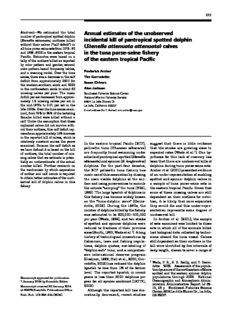
01 Archer FISH BULL 102(2).

bölüm 1
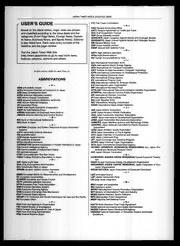
The Japan Times 2006: Index
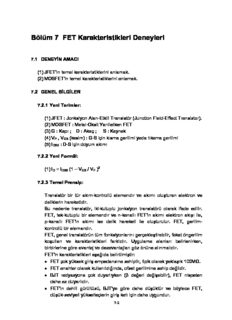
Bölüm 7 FET Karakteristikleri Deneyleri
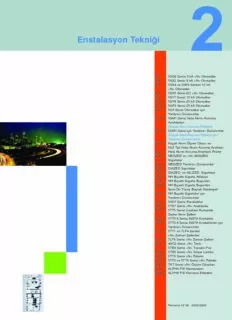
Bölüm 2 sayfa 1.backup.fm

Bölüm 10 Kronik böbrek hastalığı
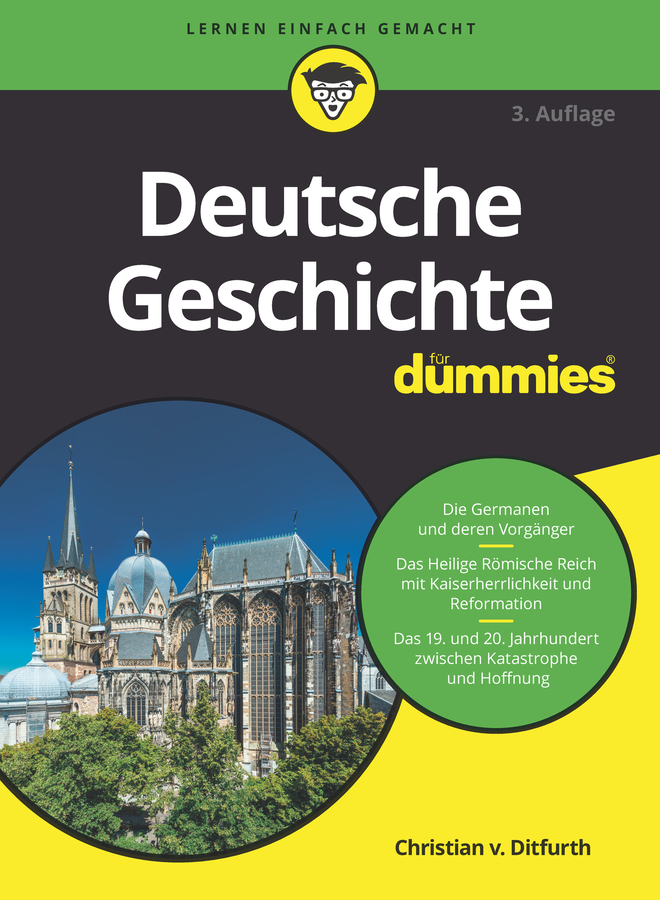
Deutsche Geschichte für Dummies
![Algebraische Strukturen [Lecture notes] book image](https://cdn.pdfdrive.to/media/content/thumbnails/0075a463-535e-4eda-ad56-e43eea31d595.webp)
Algebraische Strukturen [Lecture notes]

PR - Связь с общественностью. Хрестоматия
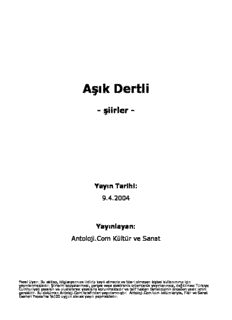
Aşık Dertli
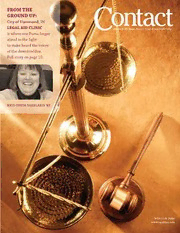
Contact Magazine - Winter, 2006 - Saint Joseph's College
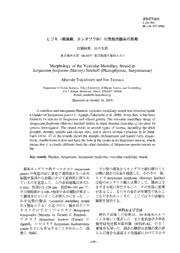
Morphology of the Vesicular Medullary Strand in Sargassum fusiforme (Harvey) Setchell (Phaeophyceae, Sargassaceae)
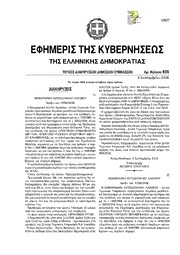
Greek Government Gazette: Part 7, 2006 no. 659
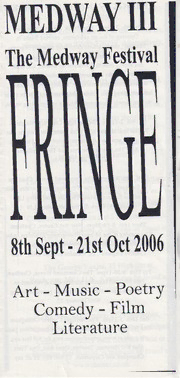
The Medway Festival Fringe 2006 Program
